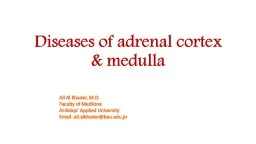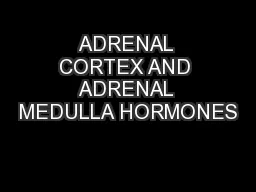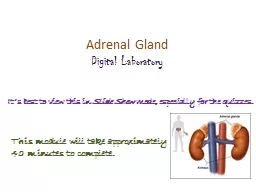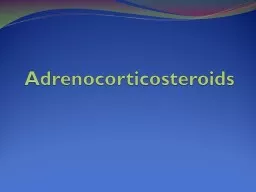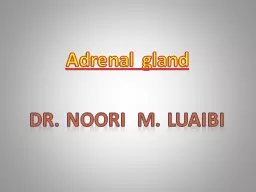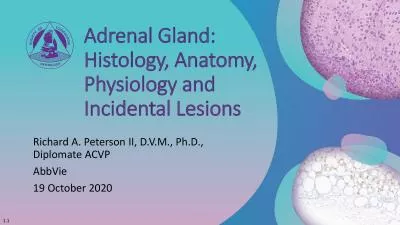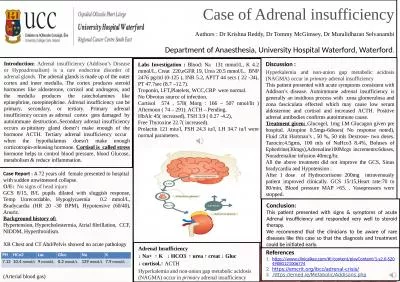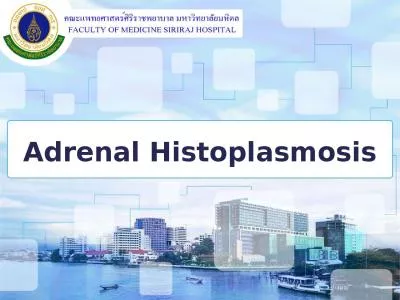PPT-Diseases of adrenal cortex & medulla
Author : eloise | Published Date : 2022-06-28
Ali Al Khader MD Faculty of Medicine AlBalqa Applied University Email alialkhaderbauedujo Lecture outline Adrenocortical hyperfunction Hyperadrenalism Hypercortisolism
Presentation Embed Code
Download Presentation
Download Presentation The PPT/PDF document "Diseases of adrenal cortex & medulla" is the property of its rightful owner. Permission is granted to download and print the materials on this website for personal, non-commercial use only, and to display it on your personal computer provided you do not modify the materials and that you retain all copyright notices contained in the materials. By downloading content from our website, you accept the terms of this agreement.
Diseases of adrenal cortex & medulla: Transcript
Ali Al Khader MD Faculty of Medicine AlBalqa Applied University Email alialkhaderbauedujo Lecture outline Adrenocortical hyperfunction Hyperadrenalism Hypercortisolism Cushing syndrome. Digital Laboratory. It’s best to view this in . Slide Show . mode, especially for the quizzes.. This module will take approximately 40 minutes to complete.. After completing this exercise, you should be able to:. Adrenal . glands. . are. . two. . pyramid. -. shaped. . structures. . that. sit on top of . the. . kidneys. , . one. . gland. . each. . kidney. .. Adrenal . glands. . release. . hormones. The . adrenal glands (suprarenal glands). are located on top of each kidney.. Adrenal Glands. Copyright © 2014 John Wiley & Sons, Inc. All rights reserved.. Cortex . (outer) – bulk of gland (75%); glandular tissue. It’s best to view this in . Slide Show . mode, especially for the quizzes.. This module will take approximately 40 minutes to complete.. After completing this exercise, you should be able to:. . identify, at the light microscope level, each of the following:. . DR. APEKSHA PANWAR. DEPARTMENT OF KRIYA SHARIR. HAMC. 4-. 1. Ch. 4-- Study Guide . Critically read (1) pages pp. 61-69 before . postsecretory metabolism of adrenal cortical hormones . section; (2) pp. 71-76 (physiology of the mineralocorticoids) before . Erin Pein, RN-BSN. What is Adrenal Insufficiency?. AI is a medical condition in which the adrenal glands cannot produce glucocorticoid hormone Cortisol. Cortisol is needed for the body to maintain normal energy supply, fluid and electrolyte balance, blood pressure, blood sugar and the body’s reaction to physical stress such as illness or injury.. Luaibi. Adrenocortical Hormones. The two . adrenal glands. , . each of which weighs about . 4. grams, lie at the superior poles of the two kidneys. As shown in Figure 77–1, each gland is composed of two distinct parts, the . catecholamines. , whereas the cortex secretes two types of corticosteroids (. glucocorticoids. and . mineralocorticoids. ) and the adrenal androgens. . The adrenal cortex has three zones, and each zone synthesizes a different type of steroid hormone from cholesterol. The outer . . M. . Luaibi. Adrenal GLANDs. The adrenal glands are . small. , . yellowish. organs that rest on the upper poles of the kidneys in the . Gerota. fascia. . The right adrenal gland is . pyramidal. Histology, Anatomy, Physiology and Incidental Lesions Richard A. Peterson II, D.V.M., Ph.D., Diplomate ACVPAbbVie19 October 2020 1.1 The Adrenal Gland Most common endocrine organ associated with che Authors : Dr Krishna Reddy, Dr Tommy McGimsey, Dr Muralidharan Selvanambi. Department of Anaesthesia, University Hospital Waterford, Waterford. .. Introduction: . Adrenal insufficiency (Addison’s Disease or Hypoadrenalism) is a rare endocrine disorder of adrenal glands.. Histoplasmosis. Organism: . Histoplasma. . capsulatum. . Most common fungal infection involving adrenal glands. More prevalent in immunocompromised patients. AIDS. Transplant recipients. Hematologic malignancies. ADRENAL GLAND. Adrenal Gland Location. The . Adrenal Glands are found on top of each kidney. Even the name “Adrenal” directly refers to their location: (. Latin: ad– “near” and . renes. – “kidneys..
Download Document
Here is the link to download the presentation.
"Diseases of adrenal cortex & medulla"The content belongs to its owner. You may download and print it for personal use, without modification, and keep all copyright notices. By downloading, you agree to these terms.
Related Documents

